10
DAEDALUS
A FABLE FOR COCKATOO
[ 19 rituals of resistance + re-inhabitation ]
There’s a crack in everything, that’s how the light gets in. L. Cohen1
Excursus
Ex11. Tuesday night, 1008BC - As the Cretan barge glides up the Sutherland Dock, the nightclub nymphs passing around champagne all stop and point to the cliff top where, amidst torches, a crescent moon and the haze of the milky way, the lonely silhouette of the Minotaur strides, lowing plaintively in a misery he cannot explain.2 Though his horns are gilded, he does not understand the meaning of guilt. His father was FAME itself.
Understand that cities and their precincts, as well as their people, achieve vitality not simply from the nature of what is built, but also from events that occur. Pay attention: in this production, there are only good seats, and the best one is yours. NB. From this point, feel free to jump ahead, and then double back. Pick a card, any card.3
Ex13. Dusk. An electric cello scratches through the dust in the air, as the Spandex-clad neo-Cretans wander through the ruined hall, inspecting this season’s wares. Like so many Mediterranean salamis, the 14 (and 3000 years before Title 9, equitably 7 of each sex) virgins swing languidly from the rafters, shrouded in cheesecloth. Distracted by the music and the cache of wine discovered behind a turbine, the audience drifts away, knowing that the best bits are always reserved for the Beast, stabbed with steely knives or no.4 Like Walter Benjamin’s journeys through allegory, this approach cannot be categorized or quantified; the best that we can do is “plot an itinerary through this text, and by so doing, map it (misread it).” 5
Dialectics

D1. A precedent. Out in the shifting (and shifty, sez our gov’s de-rigueur neocon sensibilities) hot sands of Dubai, Sheikh Mohhammed bin Rashid Al-Maktoum (Sheikh Mo’ to his fans – his rap album is coming soon) is rapaciously 127fabricating his very own 7 star version of tomorrow’s paradise, a Minotaur-like bastard offspring of Las Vegas and Paris (Hilton, not France, though sans slacks-wearing middle American pensioners, but replaced by moneyed + honeyed Eurotrash pensioners), out of oil profits, sand and slave labour. A tidy town megalopolis, and every Planning Minister’s dream, it will have shiny and monstrous towers, scintillating cultural attractions such as an audio-animatronic Jurassic Park™, the world’s largest indoor ski slope and a new Guggenheim™ designed by Jean-Paul Gaultier™ in the form of a gigantic gold-plated burkha. Naturally, there will be shopping galore, pricey real estate to be snapped up (Rod Stewart™ has bought “Scotland,” one of the islands in the World™ development) and all manner of licit (none beyond, mind you – beyond rap, She Mo’ has his rep to retain in the region, you see) delights to sate the jaded global urbanite who has, he says, as he sips his 2 litre Sea-sponge Martini™ while being gloriously massaged by a Filipino boy chained (humanely, mind) to his deck chair, “seen it all.”6
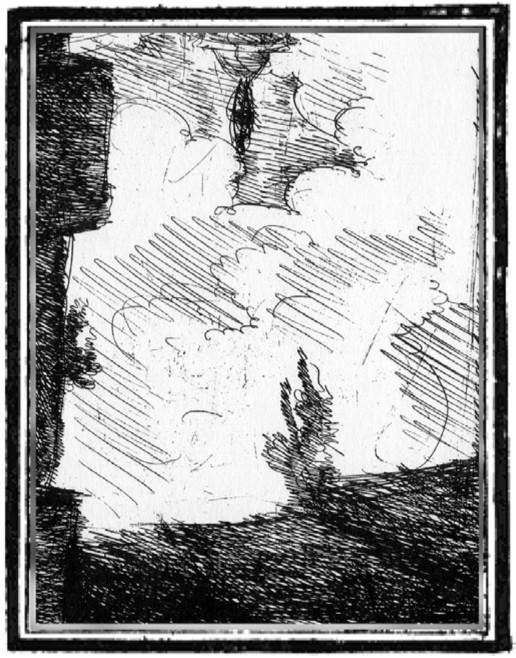
Ex2. Friday night, in a western town in a dead end world. Outside a former convict workshop in a parking lot strung with 10,000 meters of silver twine, illuminated by 1000 twinkling lights, and hung with 100’s of champagne flutes, Bacchus, 4 feet tall and resplendent in silver lame, whispers through the crowd, his chromed Richard Nixon mask concealing his lovelorn grief. Cutting glasses from the web, he holds them out as faceless black-clad servants dispense first a clear liquid, then a pinch of white powder then, as the contents effervesce to the top of the glass, a blue liquid that extinguishes the effervescence. Only the owners of Bacchus’ Bar could have managed to get 24 cases of real Absinthe past customs and on to the Island.
Coparceny
C1. Our guide for the first part of the journey is Giambattista Piranesi, in his guise as mapmaker, the creator of the magnificent and (deliberately) incomprehensible Campo Marzio 128Iconographia, a series of plates purporting to depict a plan of ancient Rome. The maps, though, bear little resemblance to Rome, instead being a collage of the real, the imagined, the prospective and the impossible.7 Along with a homemade metal detector (based on a design by Walter Benjamin), he carries with him a heavily annotated volume by Jorge Luis Borges, so well thumbed that its title is illegible.8
Only by making room for the impossible (via the imaginary) can we ever progress. Catering simply for the possible, the likely, only whatever real estate agents9 can sell, only leads to greater and greater homogeneity as every process of realisation removes detail, elides edges, blurs images. By introducing the impossible, the unimagined, we allow new edges, conflicts, novel and unexplained juxtapositions.
Ex3. 1944, midnight. Deep beneath the rock of the island, in a moist and altogether non-sterile cavern, a room that is as much convoluted and cacophonous cabinet of curiosities as it is magician’s workshop, Daedalus, alone, works on perfecting his design for a new guidance system around the Island based on his experiences in both the Labyrinth and the sky. Abandoning the strangely analog correspondence of GPS technology, he devises a neonavigational narrative system based on historical correspondence, mood rings, and a randomiser algorithm banned by the CIA. He calls it NAV, or non-linear arrayed video.10
Eduction
Ed1. Romeo Castellucci talks of the need to create works (for the theatre, his milieu, but he may just as well be talking about the city) that “represent something that doesn’t exist, and cannot be represented.” 11 His work (and ours) does not attempt to represent the unknown, only allow us to live with it. At the same time, the impossibility of representation introduces the necessity of the personal experience as the filter through which we read event, place and their confluence. The further specific events are delineated, the less centralised the work becomes; this has the effect of lending a certain interruption, a locational and situational fracture. This disassociation, which eschews contrived resolutions common to network sitcoms and design studios, allows disparate elements to exist – in a framework of openness and ambiguity which is, one hopes, more typical of life than of art.
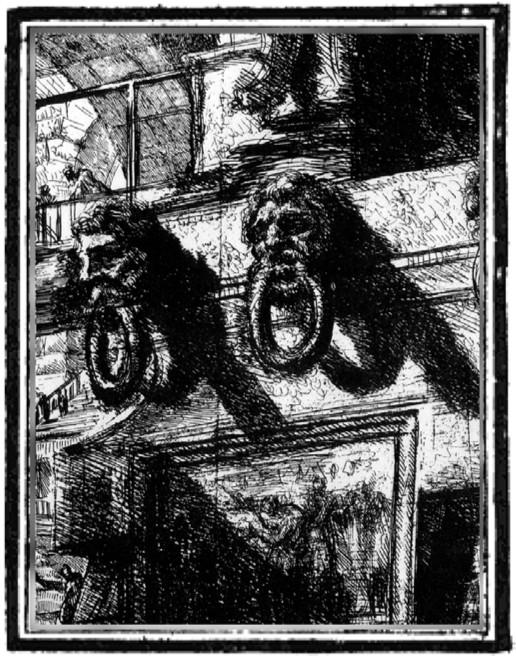
Ex4. Sunday afternoon, autumn. While a schoolgirl choir hymns lamentations for River Phoenix, 10,000 waxy feathers drift down onto the lawn behind the mess hall as a single word is scrawled across the sky, disappearing even before it can be completed: PRIDE.129

Those empirical gaps, while preventing one from ever grasping the complete scope of the project, might instead serve to allow a more important conjecture to take place: a re-writing where the viewer projects themselves, their own ideas, or their own expressions.
Ex19. Perched on the edge of water and land, the House is a machine for harvesting wind, sun, rain and dreams. The architect (it’s only resident, ever) eats its roof, while the house eats it’s own waste. Like a negligent dog owner, Daedalus spends most of his time elsewhere, while his offspring flaps and convulses about its z-axis. Unwittingly, his latest invention is designed to destroy buildings such as this, while leaving people bemusedly and unquestioningly standing – he has licensed it to the Ministry of Planning.
The history, and the magic, of islands have always been bound up in processes of discovery, communication and creation. Over time, engagement with and development of these special places revolves around what we find there, what we bring there, and ultimately, what we make there. This involves 2 acts: reading and writing.
Ed2. Italo Calvino believes, as you would suspect, in “writing,” an act which manifests both the fictional and the “real,” both internally (as we read) and externally (as we write). This matter of writing, its constituent glyphs, continuously form and reform, on a shifting surface that changes only when we do, as well as whenever we look away. 12
We advocate an architecture of obscurity, mystery and richness. It would seem that those relationships which can still maintain (if not generate) desire (erotic, aquatic, tectonic) are, strangely, unclear relationships. Frankly, Antonio Banderas was a lot more interesting in those Zorro films before he took off his mask and spoke; and how satisfying was it to see Anakin Skywalker finally put on his Darth mask and save us all from yet more execrable acting? 13
Ex12. Half past Midnight. “In the cavernous space of the turbine hall, amorphous bodies float adrift invisible currents of air. Glowing gently, floating randomly, they beckon to the body to join them, to abandon gravity. Nothing more is planned.” 14 As proprietary as ever, Apollo welcomes his children home, decrying their love of media attention all the while.
To find true perception beyond the purely visual and scenographic, Steven Holl tells us, we need to get over the banal urgency of “things to do.” This involves not necessarily a repudiation of context as content, but rather an equinamitous balancing of external sensibilities with personal intuition, “that inner life which reveals the luminous intensity of the 130world. An awareness of one’s unique existence in space is essential in developing a consciousness of perception.” 15
“One velvet morning when I’m straight, I’m gonna open up your gate, and maybe tell you about Phaedra, and how she gave me life, and how she made it end” L. Hazelwood. 16
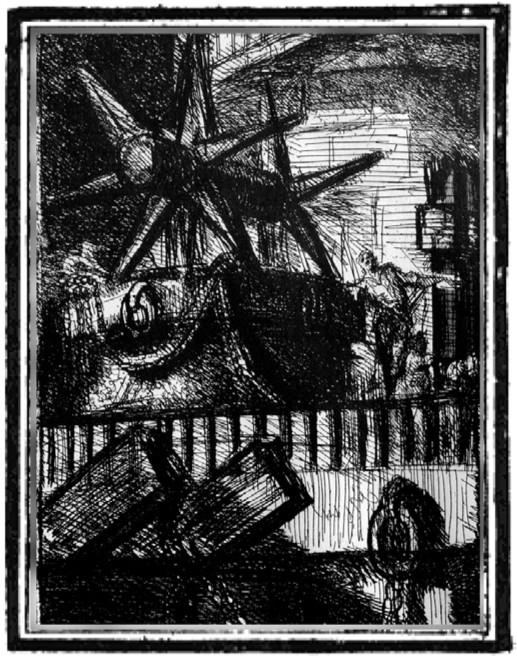
Ex7. 6 months into the future, every street corner. Even though you know that every tiny bronze card set into the pavement cannot possibly indicate a real security camera, the logo of Poseidon Security, the post war Kellogg-Root spin-off hired to “securitise” the city, suggests otherwise: “We’ll be watching you.” High above the floor of the turbine hall, in a space you weren’t meant to see into, a bank of monitors show the immediate past, the unvarnished present and, if you look long enough over the shoulders of the jack-booted guards, your future.
D2. An example. Salivating at the notion of international stature (by standing on a really, really big soapbox), everyone’s favourite Uncle Frank17 is juicily aiming to insert (repeatedly, and vigorously) a bit of Sartorial splendour into Redfern-Waterloo in the form of a whole lotta new tall buildings passionately erected by his colleagues at Merevac, Merton and Merkin, and comprising the Holy Trinity of urban development, NSW style: The patrimony of Office and Retail Space, its sacred offspring Housing (as in “Jesus, look at that pile of shit!”), and the Holy Ghost of real estate agents from here to the Rodeo Drive, Le Car Parking. This is urban development as religious dogma or, better, as body building, confined to a limited set of (eminently quantifiable) operations (or poses) where bigger is, of course, always better. This institutional inability (or worse, unwillingness) to conceive of Sydney as anything more than a series of sites of deracination, desalination and developmentation (instead of, say, delectation and degustation18) resulting in banal buildings with embarrassing appellations (developed in focus groups) dooms the city to a future as bleak as that of the Gold Coast or the Costa del Sol.
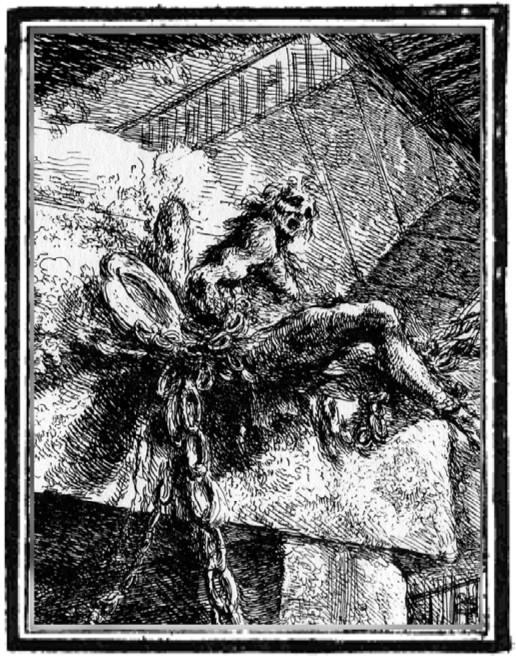 131
131
Ex6. 2am, the Turbine Hall. The Chemical Brothers finish their set in a characteristic giga-bitten flurry of light and sound pyrotechnics, leaving the frenzied thousands addled and dripping, perfectly tenderised for the headline act. Taiko drummers on platforms suspended from the rafters pound out a bone shuddering beat, as a dangling troupe of Butoh dancers contort at a speed measured in beats per hour, not minutes. The lights dim further, then throb, and finally, preceded by a raft of security staff dressed as vestal virgins, the White Bull, shirtless, buffed and glistening, larger than life, bigger than Beazley, comes on stage to close the night.
C2. Our guide for the second part of the journey is Gordon Matta-Clark, famous (or infamous, if you were either an official of the City of New York, or a slum landlord with a crumbling building) for his incisions, excisions, insertions and interruptions of buildings, the built fabric and the urban social order. He has bought along his illegitimate (whatever that means these days) daughter Orlan. Precocious beyond her years, she carries with her a box of knitting needles and a dismembered and partially reconstructed Barbie doll – she claims that it is a map.
Ex14. Early morning, summer. A flotilla of black sails drift into the docks, ghosted images barely printed on their surface, mirroring empty spaces, selling souls and announcing (yet again) the triumph of age and guile over youth and exuberance. And like Ronnie Reagan in his blissfully ignorant dotage, we all wish we could forget so completely those things that had been done.
The ongoing history of Cockatoo Island is one of accretion, adaptation and change. We intend to promote this distinct character but move beyond the static nature of industrial production into the realms of imagination. Throughout much of its history, the island has been inhabited by many different groups, all reworking the island, its productive capabilities and, most importantly, their lives. We view this multiplicity of uses as one of the most vibrant resources that exists in the Island’s history and for the future development of Cockatoo Island as a vibrant (and impossible) precinct in Sydney. Thus, we propose not one thing, nor one profession, nor one activity, but a multitude. 19
Ex17. One summer afternoon, last year. Disguising the waxed cruisers in their midst, the flock of seagulls (really, pigeons with hairdo’s) ascend in unison into the sky, paparazzi snapping every Lady Di (Dead)-like flutter and coquetry. This divine geometric choreography so transfixes the happy snap crowd below that hardly anyone notices the obnoxious blond boy silently fall into the oily harbour. Two dozen people got it, though, on their Polaroids.
The terror that faces us is that of the all-inclusive, the pre-ordained, the master planned. How do we make room for the unknown?
Ex5. 4 weeks in the spring. In a damp and cold concrete bunker, 2 incarnations of Pasiphae (one regretful at her transgression, the other lamenting the loss of what is, after all, still her son) stitch together thousands of cloth fragments into a gigantic bedsheet. She (they), assisted by passersby, write the names of all the war dead on the scraps, them black them out. On March 20, the bunker is completely wrapped in the quilt, a 132pixilated funeral shroud. The work is called Atyaf20. The ink cannot be removed from their hands.
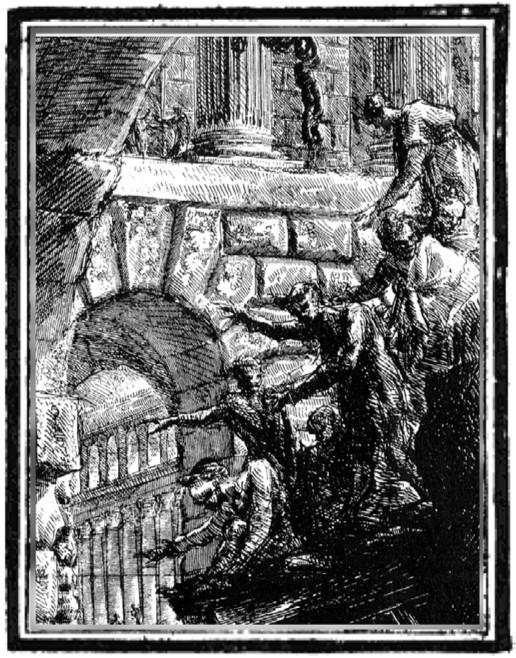
Ed3. “For Teddy Cruz, development often defines a process of flattening the landscapes, both physically and culturally, in what might be described as a form of cultural holocaust. Thus, if our fingerprints form an essential attribute of personal identification and differentiation, the same might analogously be said of the natural and cultural contours of our cities, the destruction of which (through gentrification and sprawl) also destroys the individuality and identity of our cities.” 21
Ex8. November 22, 9pm. Amidst the great, encrusted machines, silent and attendant, only a chalk outline remains of Talos, brilliant, mercurial, and doomed to an early death in the presence of a man who was less clever, less inventive, less intuitive, but altogether more powerful (or more obsequious to power). Jealousy of a skill one can never attain can be quite a weapon in the hands and minds of those nearly competent grey fellows behind grey machines who make the day to day decisions in the city. But already, Talos’ colleagues have vowed to lodge an appeal with the LEC. 22
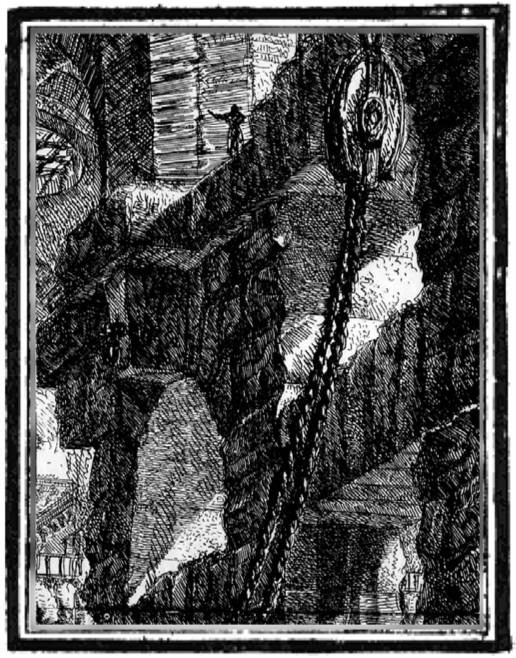
The inhabitation of ruins is an act of “minor” architecture, involving as it does ambiguous objects and a dislocation of linear narrative, instead offering an assemblage of incomplete objects or events. What stands out are the joints, or those spaces between exactitude and lack of definition - they are similar to Castellucci’s gaps of interpretation.
Ex15. We had lost all sense. Time became strange. The crane a blue chicken, the destroyer dock buzzing with activity. In our delirium, we listened to the thin red line of talking bricks that told us stories, and led the way through, no never in the same place twice, nor in the same order. Some bricks refused to speak, and were given sentinel duty instead. 23
D3. Close your eyes and imagine some kind of likely scenario: 2011, Saturday, 3:30pm, Cockatoo Island. As your 133water taxi from Point Piper pulls up, spewing diesel fumes, you recognize Eddie Macguire’s superyacht, “Eddie,” moored alongside the VIP dock for Hugo’s Waterside Bar and Brothel and Model Hangout. Eddie’s Filipino butler is gently backing Eddie’s Maserati convertible, license plate “Eddie,” onto the wharf. Fellow convertible owners and their respective models either wave or pout, as decorum demands. You hope this doesn’t mean there’s going to be a queue for the loos again once everyone gets in. At least there are no more sniffer dogs since the NSWPF was privatized and bought by Halliburton. Chopper Read24 is the new Commissioner, and he seems to be doing a great job. As you hop onto the Harry Seidler Memorial Monorail and Waterslide for the trip up the hill, two silver plated semi-converted Apache attack helicopters thunder into view, a buff figure with a 2.8 million dollar smile hanging from the rope ladder – it’s Tom and his good pal Jamie and their Scientology retinues, arriving spot on time (and so dramatically so) for the preparty opening ceremonies of Stage 6 of the Kerry Packer Casino, Resort and Mall. It’s going to be a great night!
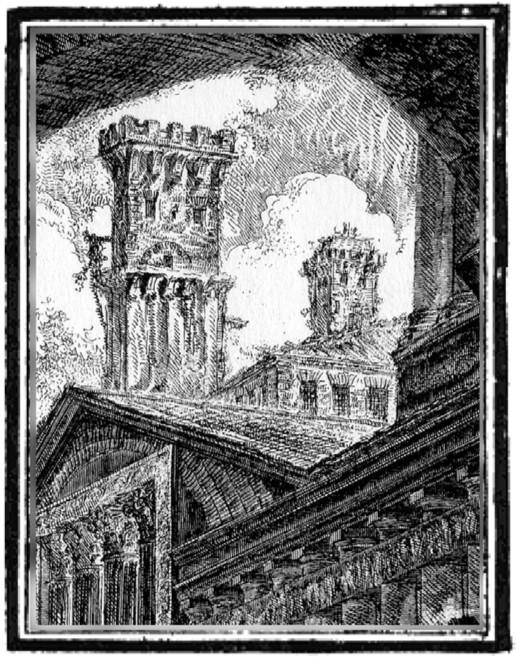
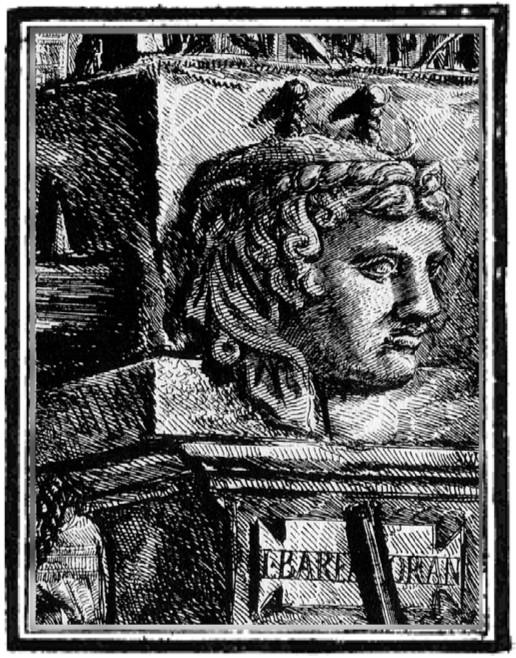
Ex10. The Bolt Store, March 7, 2007, 7pm. Only loosely contained in a somewhat cheeky box that does a thousand and one things, inside a room with a thousand and one boxes for bolts that no one uses anymore, a thoroughly modern Ariadne canvasses her shoe collection and sets out to re-write A Thousand and One Nights, from a post-Germaine, pre-President Spears point of view. The audience, though always one step behind, loves it.
A universe in a house, a city in an article.
Ex1. The Big Night Out. Shadows the size of gods play across the sandstone cliffs. Thunder rumbles from beneath the Island. The delicate and debauched party-goers (there to bear witness to the wetness of miscegenation between the Talk Show Queen and the Talk Radio Maggot) scurry prematurely for cover into the tunnels, only to retreat from the mournful soundscape surrounding them. Ever the social aesthete, especially at Cup time, Pasiphae apologises in advance for 134her lust: “It’s not my fault!” she pleads.
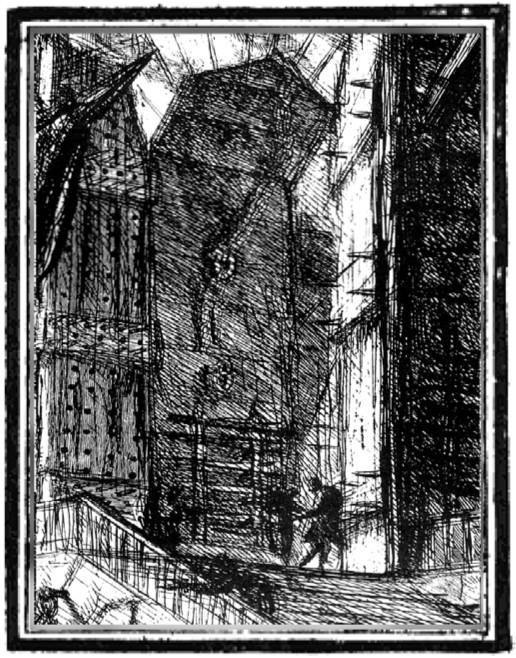
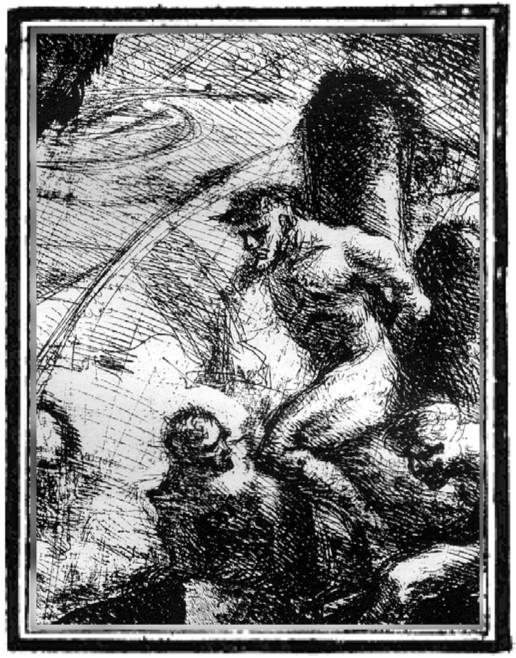
C3. Our guides for the third part of the journey are Lou Reed, poet and purveyor of a unique (and oft-emulated) urbane sensibility – fresh in from Berlin, he wears a famous blue raincoat, it’s torn at the shoulder. With him is, again, our old friend Piranesi; this time though, he comes as a much more visceral, though no less dark persona: the creator of a series of monumental etchings of prisons, mines, caves and other subterranea generally compiled as Il Carcieri. Conceived and created when in the midst of a fevered delirium, Piranesi himself prefers to title these works “Dreams.” 25
Ex9. 7pm, near the beginning. On the disused gantry, the armor clad misshapen beast clanks across, the chain saw revving in his massive mitts. Though she seems as formally serene as Whistler’s mother, the old woman rocking in the chair in front of him lets out a continuous keening howl that can be heard above the noise. Below them, behind the screen of red that showers down, Bernard, in his scrubs, calmly and carefully slices and dices the body parts, fastidiously labeling each and every transgression. The subtitles of many of the labels bear names similar to those of some very well known politicians, property developers and prostitutes, as well as their sins: Birkenhead Point, Gluttony, East Circular Quay, Jealousy, Darling Harbour, Vanity, etc.
Ed4. Crossing water has often been construed as a journey into dreams, as Bachelard reminds us: “Thus a farewell at the water’s edge is the most heartrending and, at the same time, the most literary of farewells. Its poetry makes use of an old wellspring of dreams and heroism. It awakens in us, no doubt, the most painful of echoes. One entire facet of our nocturnal soul can be explained by the myth of death conceived as a departure over water. For the dreamer, there is a continuing transposition between this departure and death. For some dreamers, water is the new movement that beckons us towards a journey never made. This materialized departure takes us away from the earth’s matter.” 26135
Ex16. Pitch Black. From across the water, the ferry passengers watched the fabric of the Island shift and slip, over and past itself, only momentarily captured in the flickering lights. Watch closely to what happens at the edges, or the boundaries, where perhaps space or enclosure begins and ends, and read (dream) the events of interaction at these points. Daedalus postulated that a black hole’s event horizon is the junction between two realities, a space-time omphalos. 27
Experience of a real place allows the eye (and the mind) to roam free among inventive details [not all of them need be concrete and present – we must learn to expand the experience of architecture beyond the senses, and beyond the physical, to incorporate the imagination]. Our experience of an urban place can only be personally perspectival, fragmented, experiential, incomplete. It is in this incompleteness that we find the opportunity for unique understanding of a place. We might even become that “participatory, critical subject.” 28
Ex18. The day after yesterday, 218 years ago. For the opening, the mayor wanted Cirque de Soleil. Instead, and in spite of this, the inflatable white shape rose anyway, hissing from the slipway, discarding slime and seagulls. The rising sun made it seem newborn, though rather like Athena, and fully formed - the White Bull rose over the Island. The question on everyone’s mind: would it ever go away, or instead linger fragrantly well beyond its sacrificial date like some cheesy chalky eternityTM. 29
“And sweet to me is foundering in this sea.”
G. Leopardi 30
1.Leonard Cohen, Anthem from The Future (Sony Music, 1992).
2.For some measure of the pathos inherent in being an immortal beast, see Steven Sherril, The Minotaur Takes a Cigarette Break (John F. Blair, 2000), which ends, elegiacally: The Minotaur dreams the brevity of hearts in a labyrinth of days, Dreams a flock of grackles settling in a field of narcissus, The birds descend in unison, their wing beats cease.
3.For one inspiration into the deliberately disordered, see Robert Coover, Heart Suite, in McSweeney’s Quarterly Concern (McSweeney’s, 2005). Presented as a gigantic pack of cards, the reader is instructed: “The 13 heart cards may be shuffled and read in any order, with this card first and the joker last.”
4.Drew Fairley, Sydney presenter and comedian, does a cracker of a performance of the old Eagles standard. Our program is to architecture what his interpretation is to the original “Hotel California.” Welcome to the abattoir of sacred cows.
5.Jennifer Bloomer, Architecture and the Text: The (S)crypts of Joyce and Piranesi (Yale University, 1993), 36.
6.Mike Davis, Does the Road to the Future End at Dubai? in Log 6 (New York: Anyone Corporation, 2005), 61-64.
7.Bloomer, op. cit., 68-72.
8. Definitely not Labyrinths; that would be too easy.
9. Apologies.
10. See, for example, The Onyx Project (http://www.theonyxproject.com/), an individual user interface narrative project that allows that “… no two viewers may see the movie unfold in the same way, yet its basic facts, characters and message will permeate the experience.”
11. From a talk given by Romeo Castellucci at NIDA, Sydney, October 7, 2006.
12. Italo Calvino, Visibility, in 6 Memos for the Next Millenium (New York: Vintage International, 1988), 99.
13. Apologies again; bad acting is rather a lot like real estate agency, though.
14. Jennifer Turpin, précis for an artwork on Cockatoo Island, Lighter Than Air, submitted to the author, 2006.
15. Steven Holl, Juhani Pallasmaa, Alberto Perez-Gomez, Questions of Perception: Phenomenology of Architecture (New York: William K Stout, 2006), 57.
16. Lee Hazelwood, Some Velvet Morning from Fairy Tales & Fantasies: The Best Of Nancy & Lee (Rhino, 1989).
17. In late 2004, the NSW government formed the Redfern Waterloo Authority (RWA), granting itself sweeping powers to displace residents and pave the way for urban renewal, via sale of community assets and approval of mega-developments. The authority is headed by Sydney’s ultra-authoritarian, the (former) Hon. Frank Sartor; he is directly accountable to the NSW Minister for planning, the (former) Hon. Frank Sartor.
18. Strangely, these connoisseurs of the convertible, the blond and the convertible bond seem to prefer the all-you-can-eat deal at the Black Stump rather than an experience at Tetsuya’s.
19. See Italo Calvino, Multiplicity, in 6 Memos for the Next Millenium (New York: Vintage International, 1988), 101-124.
20. Arabic for “Ghosts.”
21. Adam Haddow, Review of Teddy Cruz’ Lloyd Rees lecture at the MCA, August 9, 2006, in Architecture Review Australia, 098.
22. Land and Environment Court, or the final arbiter of taste, “responsible for interpreting and enforcing environmental law in the state of New South Wales, Australia.”
23. Refer Timothy Leary, The Politics of Ecstasy (Ronin Publishing, 1998).
24. Chopper Read, real name Mark Brandon Read (born November 17, 1954), is a former Australian criminal and author. Convicted of armed robbery, firearm offences, assault and kidnapping, Read spent 13 months outside prison between ages 20 and 38, then went on to become a successful author, selling in excess of 500,000 copies of his works. More recently, he has also found success as a recording artist. While in prison he had a fellow inmate cut off his ears in order to be able to leave the prison temporarily to avoid an ambush by other inmates.
25. Marguerite Yourcenar, The Dark Brain of Piranesi (New York: Farrar, Straus and Giroux, 1984), 88-95.
26. Gaston Bachelard, Water and Dreams: An Essay on the Imagination of Matter, (Dallas Institute Publications, 1999), 123.
27. Michael Lewarne, précis for a light installation on Cockatoo Island, Event Horizon, submitted to the author, 2006.
28. Bloomer, op. cit., 41. It is best, though, to recall that not everybody likes either allegory or a critical faculty. Adolf Loos of course was horrified at the thought of tattoos, while Universities today, frightened of no doubt litigiousness (or losing the affections of their affectionate charges, rather Clinton-like) find critical thought (let alone expression) censorious.
29. Pace Arthur Stace, ‘Mr Eternity’. At least 50 times a day for 30 years he wrote the word ‘Eternity’ in chalk on the streets of Sydney. Today, one is obliged to refer to City of Sydney’s Grafitti Policy: http://www.cityofsydney.nsw.gov.au/Residents/Graffiti/GraffitiManagementPolicy.asp
30.Giacomo Leopardi, Il Infinito, from The Canti (Routledge, 2003), 54.